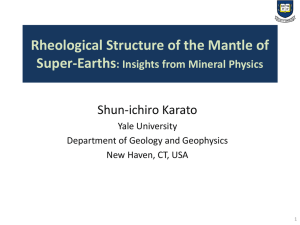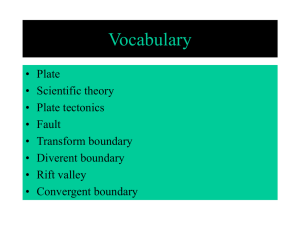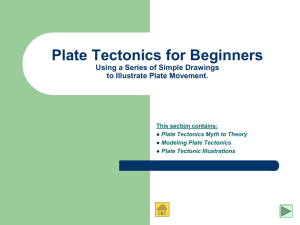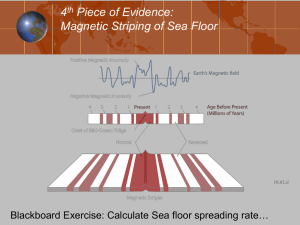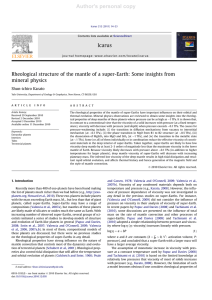leaps - The People of Geology & Geophysics
advertisement
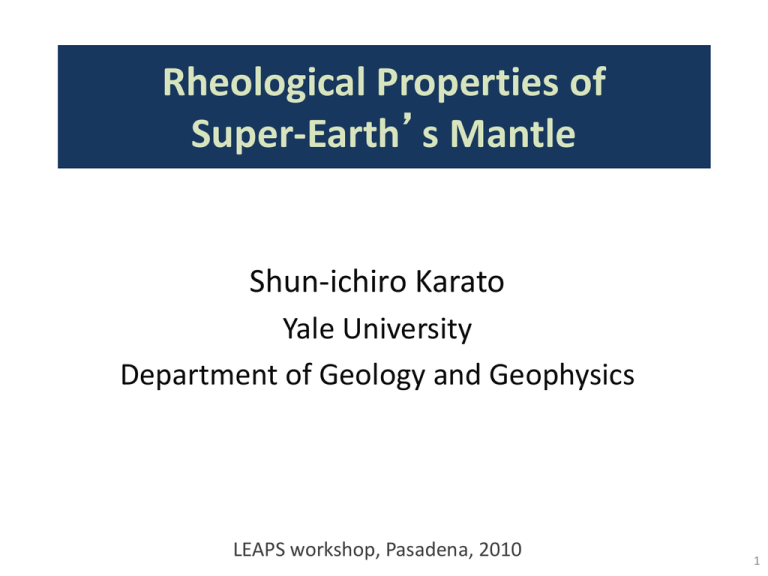
Rheological Properties of Super-Earth’s Mantle Shun-ichiro Karato Yale University Department of Geology and Geophysics LEAPS workshop, Pasadena, 2010 1 How does a super-Earth evolve? mantle convection, thermal evolution Plate tectonics is a key to habitable surface environment. Does plate tectonic operate on super-Earths? tidal heating orbital evolution How much have exo-planets migrated since their formation? Rheological properties 2 Tidal dissipation and evolution of super-Earths 1 Q µ h, 1 () 1 a h (low viscosity higher heating rate, faster orbital evolution) 3 Could plate tectonics operate on a super-Earth? How does the resistance and driving force for plate tectonics change with planetary mass? resistance: plate thickness Rayleigh number driving force: convective stress Rayleigh number Ra = r ga (T -Ts ) d 3 kh A large Rayleigh number high stress, thin plate promote plate tectonics How does the Rayleigh number change with planetary mass? (Valencia et al., 2007) P-effect on viscosity is often ignored. Is it justifiable? 4 T-P conditions P to ~1 TPa (1000 GPa) T to 5000 K 5 Viscosity of planetary materials depends strongly on T and P. P-effect is potentially very large! h = h0 exp * ( HRT* ) = h0 exp ( E*+PV RT ) (H*=300-600 kJ/mol, V*=3-10 cc/mol for typical mantle minerals) 6 T-mass relationship Mass dependence of P: P~M 2/3 energy balance 7 Viscosity-mass relationship 8 Internal structure of a super-Earth (B1 B2 transition) (dissociation of post-perovskite) A model of a super-Earth (Earth-like composition) A: upper mantle B: lower mantle C: core 9 h = h0 exp * ( HRT* ) = h0 exp ( E*+PV RT ) A linear approximation, H*=E*+PV* is not valid at high-P. V* decreases with depth (pressure) (smaller P-effect), but viscosity increases with P at a given T. (Karato, 2010) 10 Viscosity changes when mechanisms of atomic motion change. V*vacancy >0 V*interstitial <0 vacancy mechanism interstitial mechanism (from (Ito and Toriumi, 2007)) (from Karato (1978)) 11 Viscosity changes also with crystal structure. normalize viscosity normalized temperature B1 In most of super-Earth’s mantle, MgO is the softest phase. MgO changes its structure from B1 to B2 at ~0.5 TPa. (modified from Karato (1989)) 12 Materials with B2 structure are softer than those with B1 structure. h µ exp 10-4 ( ) * Gm RT 10-5 stress=1 MPa sC C 10-7 l 10-8 aC N B2 l strain-rate, s -1 10-6 10-9 B1 10-10 10-11 -12 10 1 1.2 1.4 1.6 1.8 2 Tm/T (data from Franssen (1994) and Heard-Kirby (1981)) (data from Rowell-Sanger (1981)) Fig. 3a (Karato) Dissociation of post-perovskite (MgSiO3=MgO+SiO2) increases the volume fraction of a weak MgO. 13 I: mechanism change in diffusion II: B1 B2 transition III: dissociation of post-perovskite (+ metallization?) 14 Conclusions • Effects of pressure on rheological properties are large. • If a conventional parameterization is used, viscosity increases so much with planetary mass and plate tectonics would be difficult for a large super-Earths. • Viscosity of the mantle of a super-Earth likely decreases with pressure and hence decreases with planetary mass. plate tectonics is possible in large planets. • Low viscosity of the deep mantle high tidal dissipation rapid orbital migration + substantial heating. (effects of tidal dissipation is much larger for rocky planets than for gaseous planets: influence of tidal dissipation on orbital migration of superEarths will be important to 1-2 AU) 15
